二叉树的前序遍历,前序遍历的顺序是,根,左子树,右子树
//二叉树的前序遍历
void PreOrnder(BTNode* root)
{
if(root == NULL)
{
printf("NULl ");
return;
}
printf("%c ",root->data);
PreOrnder(root->left);
PreOrnder(root->right);
}二叉树的中序遍历,中序遍历的顺序是,左子树,根,右子树,下面是详细的递归过程
//二叉树的中序遍历
void InOrnder(BTNode* root)
{
if(root == NULL)
{
printf("NULl ");
return;
}
InOrnder(root->left);
printf("%d ",root->data);
InOrnder(root->right);
}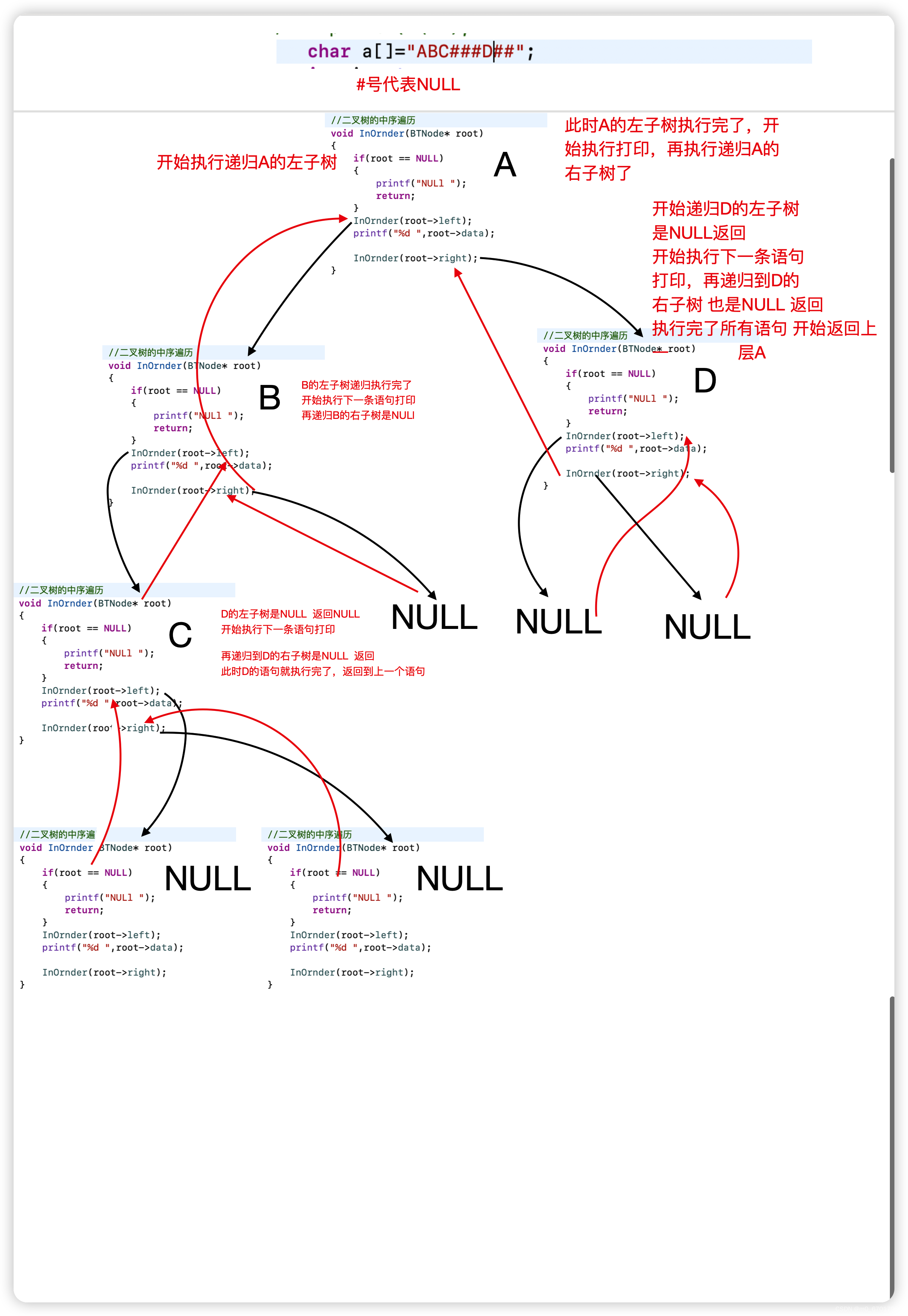
二叉树的后序遍历,遍历的顺序是左子树,右子树,根,比较类似于深度优先算法,DFS
//二叉树的后序遍历
void PostOrder(BTNode* root)
{
if(root == NULL)
{
printf("NULl ");
return;
}
PostOrder(root->left);
PostOrder(root->right);
printf("%d ",root->data);
}如何计算二叉树的叶子个数,叶子的特性是左子树是NULL,右子树也是NULL,所以我们可以用递归遍历的方法,加个if判断,左子树是NULL,右子树也是NULL,则这个是叶子
//二叉树的叶子个数
int TreeLeafSize(BTNode* root)
{
if(root == NULL)
{
return 0;
}
if(root->left == NULL && root->right == NULL)
{
return 1;
}
return TreeLeafSize(root->left) + TreeLeafSize(root->right);
}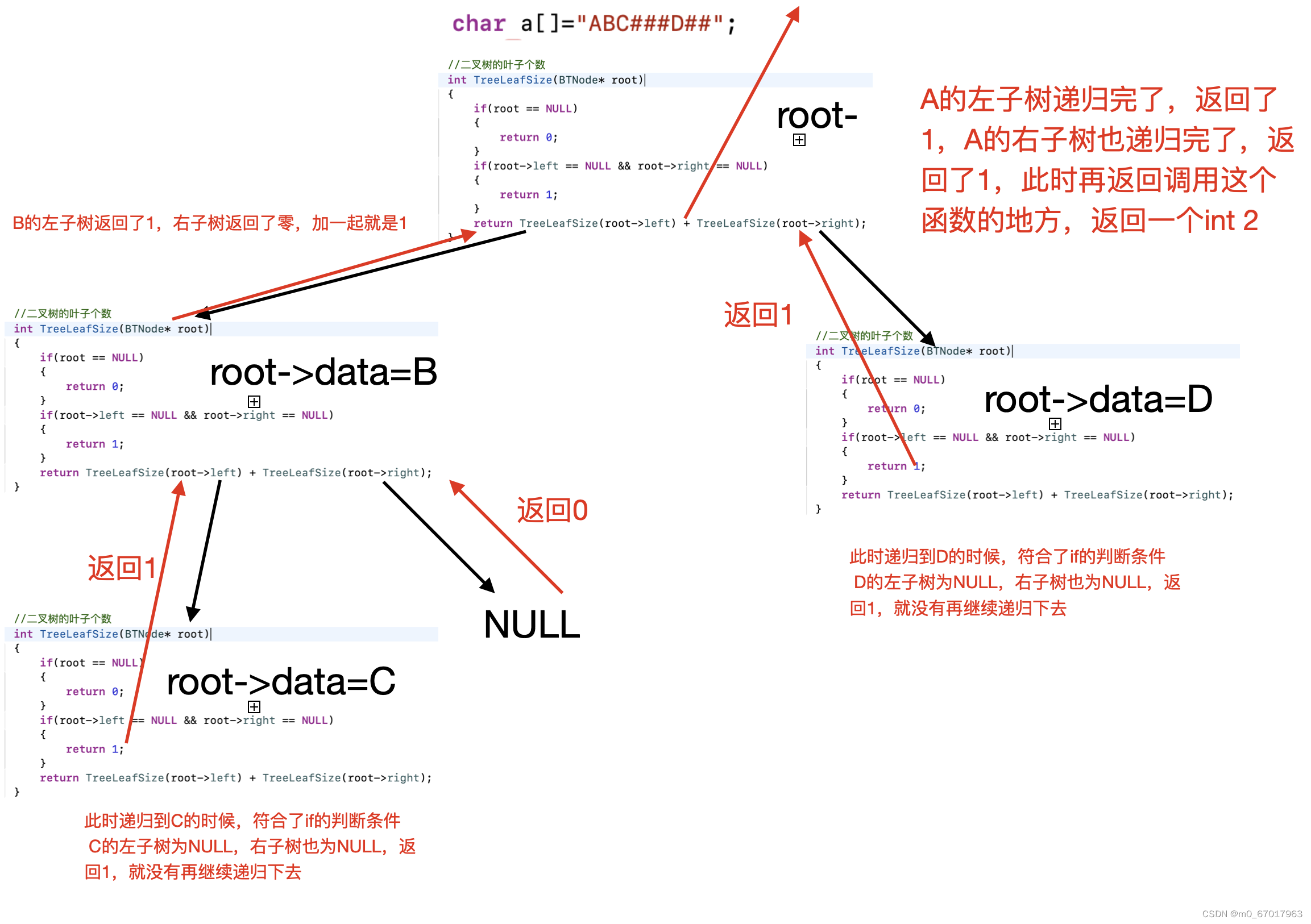
寻找二叉树中的某个数,找到了返回那个数的地址,没有找到就返回NULL
//寻找二叉树中的某个数
BTNode* TreeFind(BTNode* root,BTDataType x)
{
if(root == NULL)
{
return NULL;
}
if(root->data == x)
{
return root;
}
BTNode* lret = TreeFind(root->left, x);
if(lret)
{
return lret;
}
BTNode* rret = TreeFind(root->right, x);
if(rret)
{
return rret;
}
return NULL;
}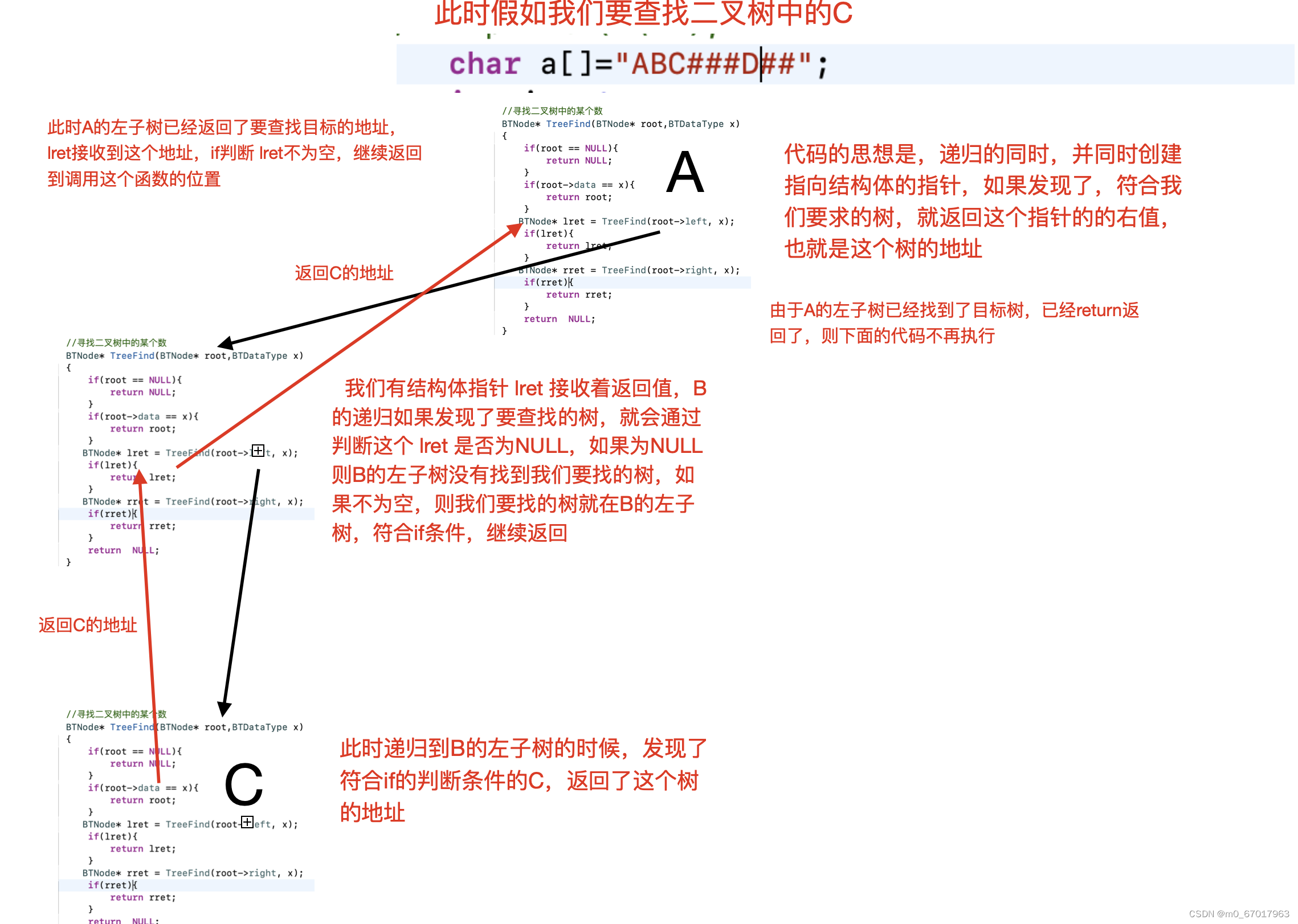
获取二叉树的节点个数,也是用递归来实现的,每递归到一个树的时候,只要不为空就返回1,把返回的1都加上再返回到调用这个函数的位置
int TreeSize(BTNode* root)
{
return root == NULL ? 0 : TreeSize(root->left) + TreeSize(root->right)+1;
}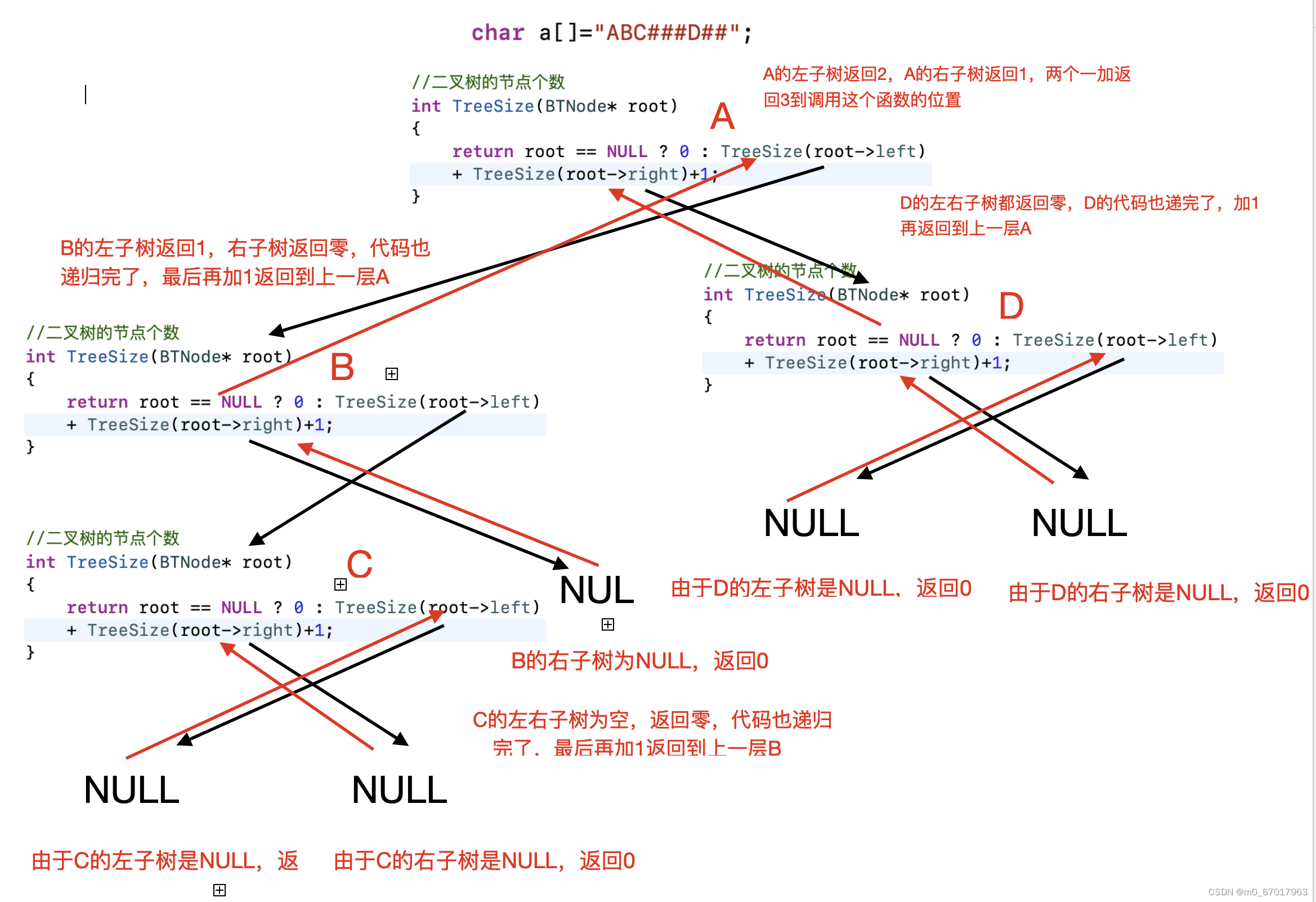
查找第K层的节点个数,也是递归遍历,等递归到K层后,开始返回节点个数,跟上一个获取节点个数是一样的,只不过多了一个判断,到达K层才开始返回
//查找第K层的节点个数
int TreeKLevel(BTNode* root, int k)
{
assert(k > 0);
if(root == NULL)
{
return 0;
}
if(k == 1)
{
return 1;
}
return TreeKLevel(root->left, k-1)+TreeKLevel(root->right, k-1);
} 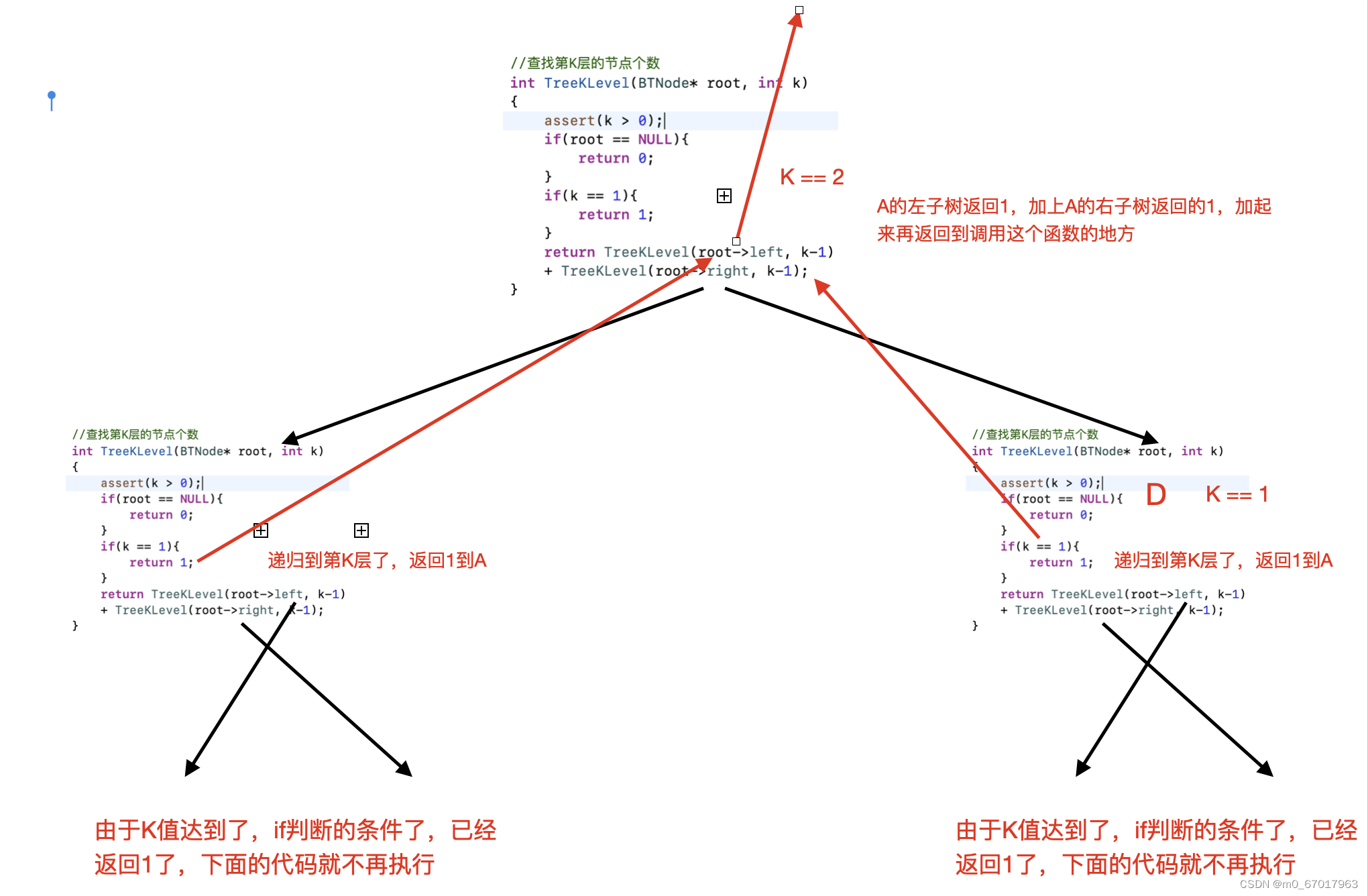
获取二叉树的最高高度
//二叉树的高度
int TreeHight(BTNode* root)
{
if(root == NULL)
{
return 0;
}
int lh = TreeHight(root->left)+1;
int rh = TreeHight(root->right)+1;
return lh > rh ? lh : rh;
}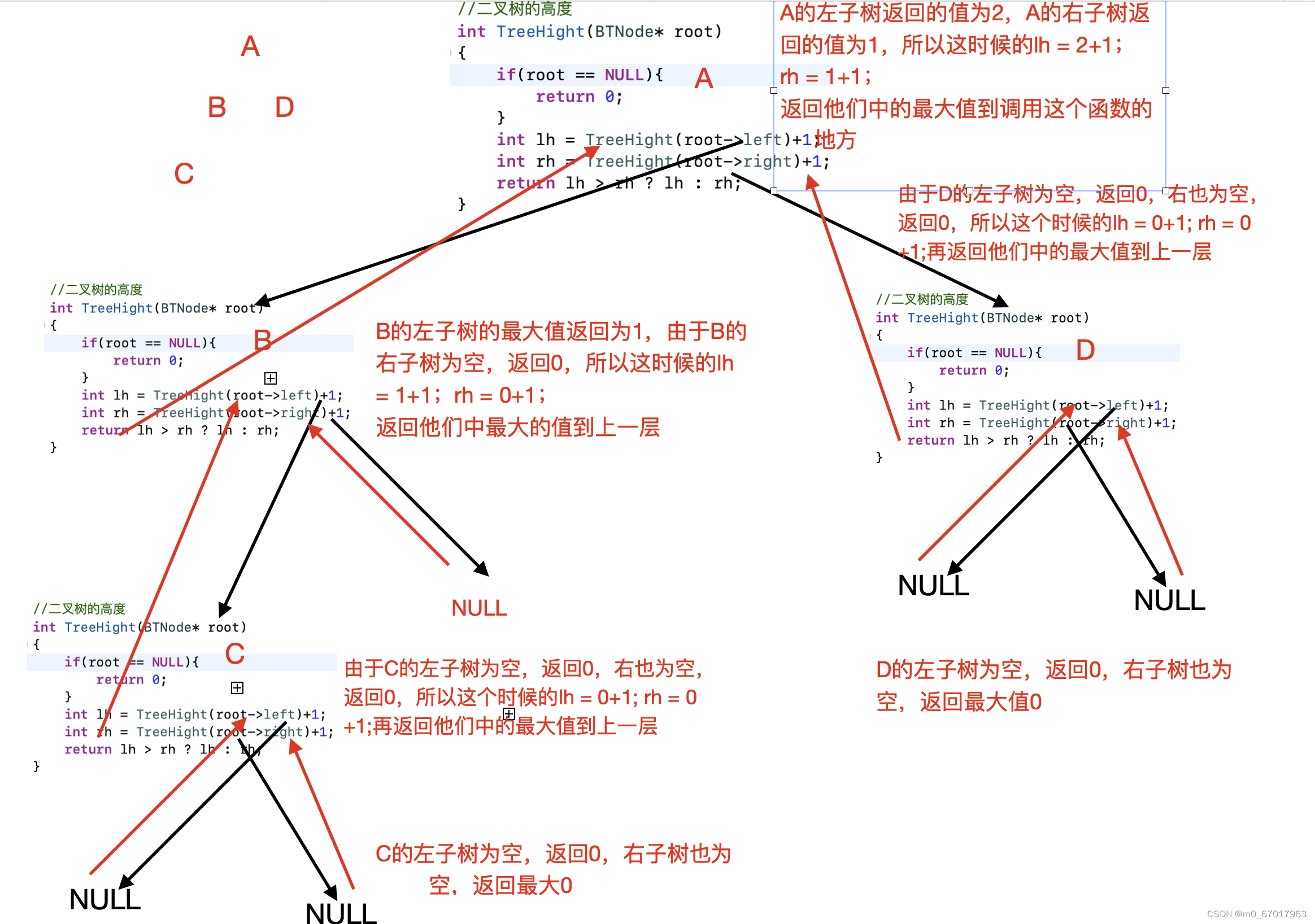
二叉树的层序遍历,层序遍历是比较像广度算法BFS的,实现过程需要有一个队列
// 层序遍历
void BinaryTreeLevelOrder(BTNode* root)
{
Queue q;
QueueInit(&q);
if(root)
{
QueuePush(&q, root);
}
while(!QueueEmpty(&q))
{
BTNode* front = QueueFront(&q);
QueuePop(&q);
printf("%c ",front->data);
if(front->left)
{
QueuePush(&q, front->left);
}
if(front->right)
{
QueuePush(&q, front->right);
}
}
printf("
");
QueueDestroy(&q);
}
//队列的几个接口代码
typedef BTNode* QDataType;
// 链式结构:表示队列
typedef struct QListNode
{
struct QListNode* _next;
QDataType _data;
}QNode;
// 队列的结构
typedef struct Queue
{
QNode* _front;
QNode* _rear;
int size;
}Queue;
//队列的初始化
void QueueInit(Queue* q)
{
assert(q);
q->size = 0;
q->_front = q->_rear = NULL;
}
// 删除队头
void QueuePop(Queue* q)
{
assert(q);
assert(!QueueEmpty(q));
if(q->_front->_next == NULL)
{
free(q->_front);
q->_rear = q->_front = NULL;
}
else
{
QNode* del = q->_front;
q->_front = del->_next;
free(del);
del = NULL;
}
q->size--;
}
// 获取队列头部元素
QDataType QueueFront(Queue* q)
{
assert(q);
assert(!QueueEmpty(q));
return q->_front->_data;
}
// 检测队列是否为空,如果为空返回非零结果,如果非空返回0
int QueueEmpty(Queue* q)
{
assert(q);
if(q->_front == NULL && q->_rear == NULL)
{
return -1;
}
else
{
return 0;
}
}
// 队尾入队列
void QueuePush(Queue* q, QDataType data)
{
assert(q);
QNode* newnode = (QNode*)malloc(sizeof(QNode));
if(newnode == NULL)
{
perror("Queuepush malloc fail");
exit(-1);
}
else
{
newnode->_data = data;
newnode->_next = NULL;
}
if(q->_rear == NULL)
{
q->_rear = q->_front = newnode;
}
else
{
q->_rear->_next = newnode;
q->_rear = newnode;
}
q->size++;
}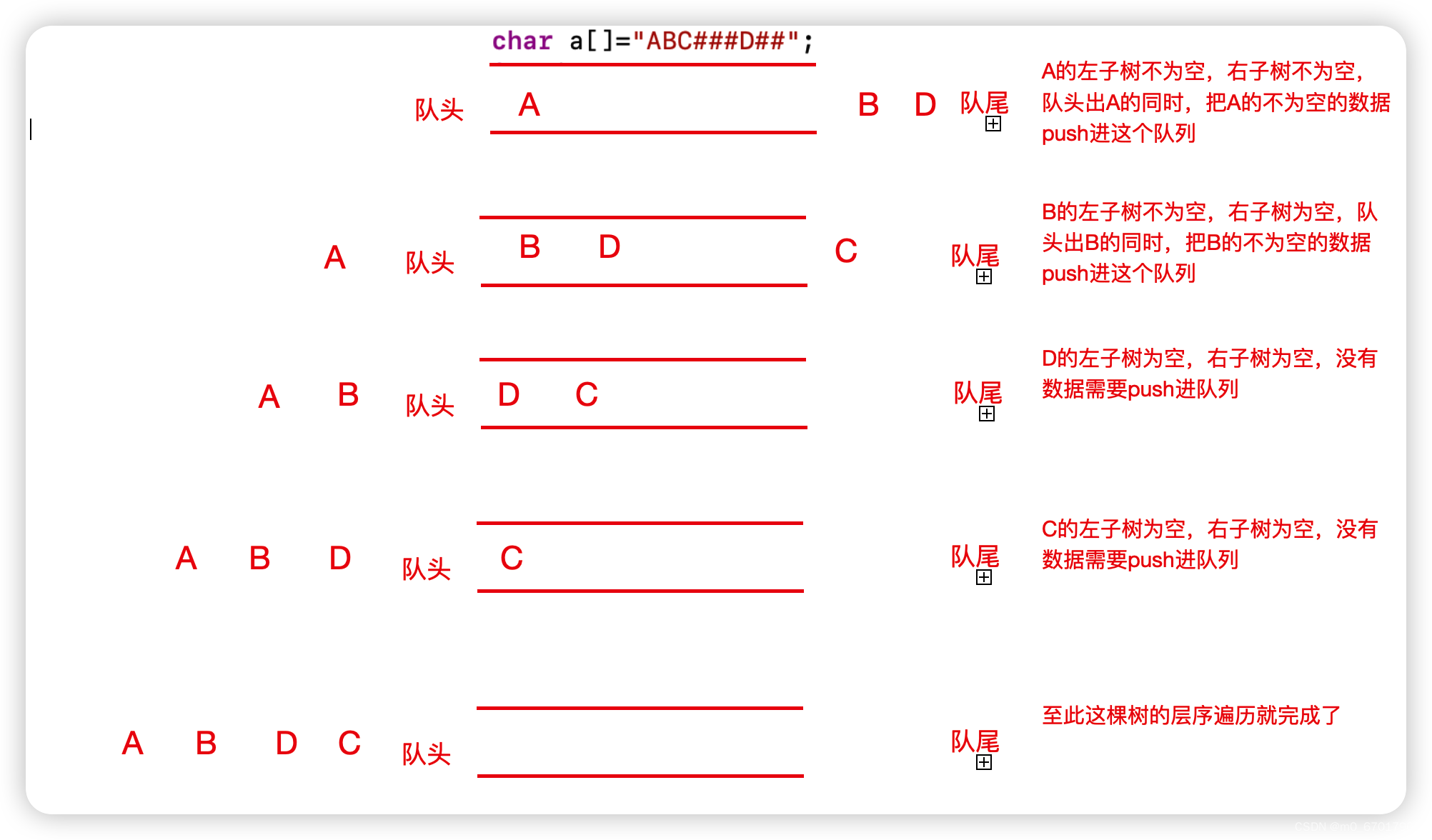
判断这棵树是否完全二叉树,完全二叉树的特点:叶子结点只能出现在最下层和次下层,且最下层的叶子结点集中在树的左部。需要注意的是,满二叉树肯定是完全二叉树,而完全二叉树不一定是满二叉树,这里还是用层序的方法去判断,如果一个二叉树在遍历到NULL的时候,后面还有,不是空的树出现。这棵树就一定不是完全二叉树。
// 判断二叉树是否是完全二叉树
int BinaryTreeComplete(BTNode* root)
{
Queue q;
QueueInit(&q);
if(root)
{
QueuePush(&q, root);
}
while(!QueueEmpty(&q))
{
BTNode* front = QueueFront(&q);
QueuePop(&q);
if(front == NULL)
{
break;
}
QueuePush(&q, front->left);
QueuePush(&q, front->right);
}
while(!QueueEmpty(&q))
{
BTNode* front = QueueFront(&q);
QueuePop(&q);
if(front != NULL)
{
QueueDestroy(&q);
return false;
}
}
QueueDestroy(&q);
return true;
}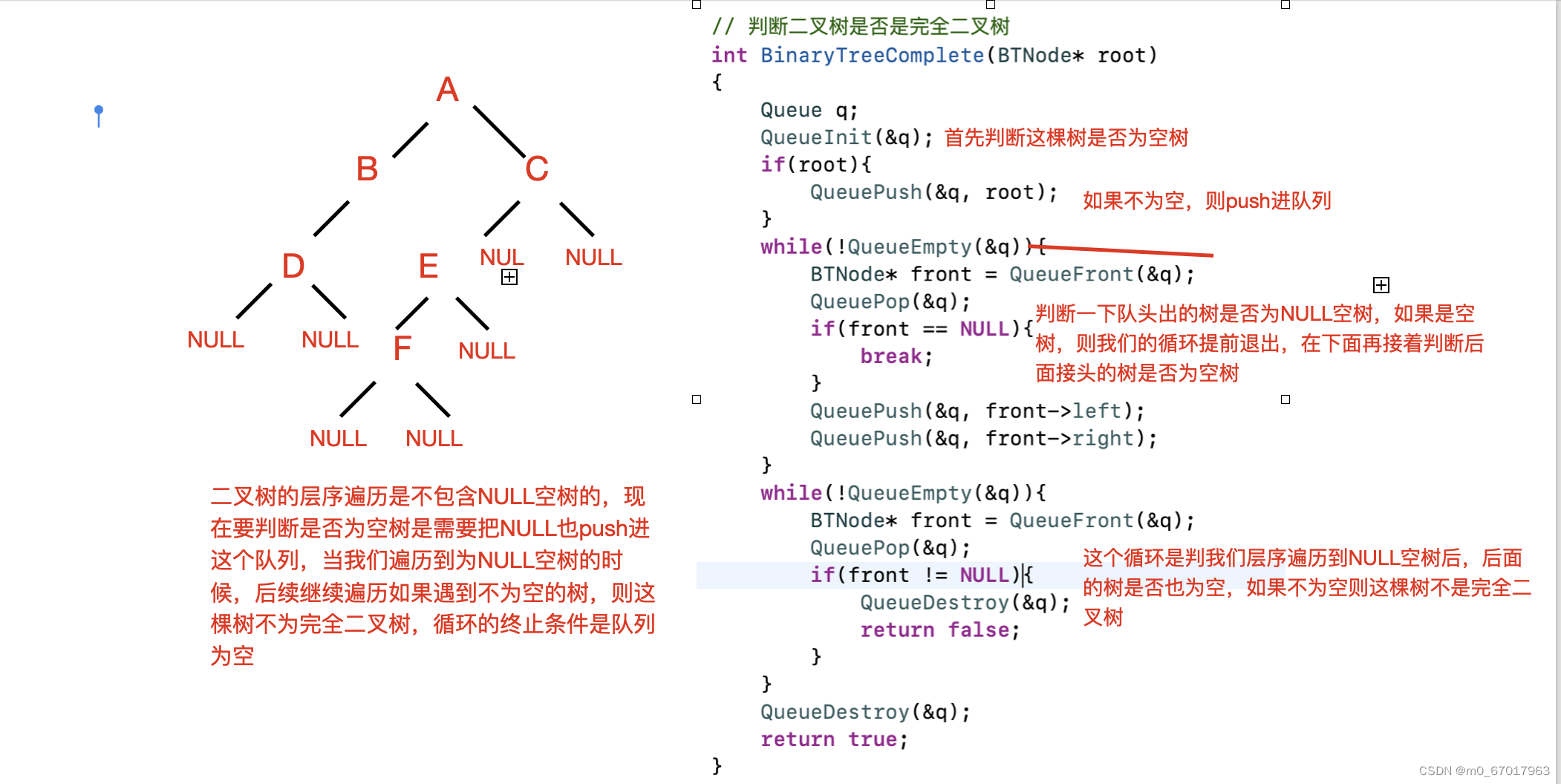 通过遍历一个数组,根据数组里面的内容,来创建一棵树
通过遍历一个数组,根据数组里面的内容,来创建一棵树
// 通过前序遍历的数组"ABD##E#H##CF##G##"构建二叉树
BTNode* BinaryTreeCreate(BTDataType* a,int* pi)
{
if(a[*pi] == '#')
{
(*pi)++;
return NULL;
}
BTNode* root = (BTNode*)malloc(sizeof(BTNode));
root->data = a[(*pi)];
(*pi)++;
root->left = BinaryTreeCreate(a,pi);
root->right = BinaryTreeCreate(a,pi);
return root;
} 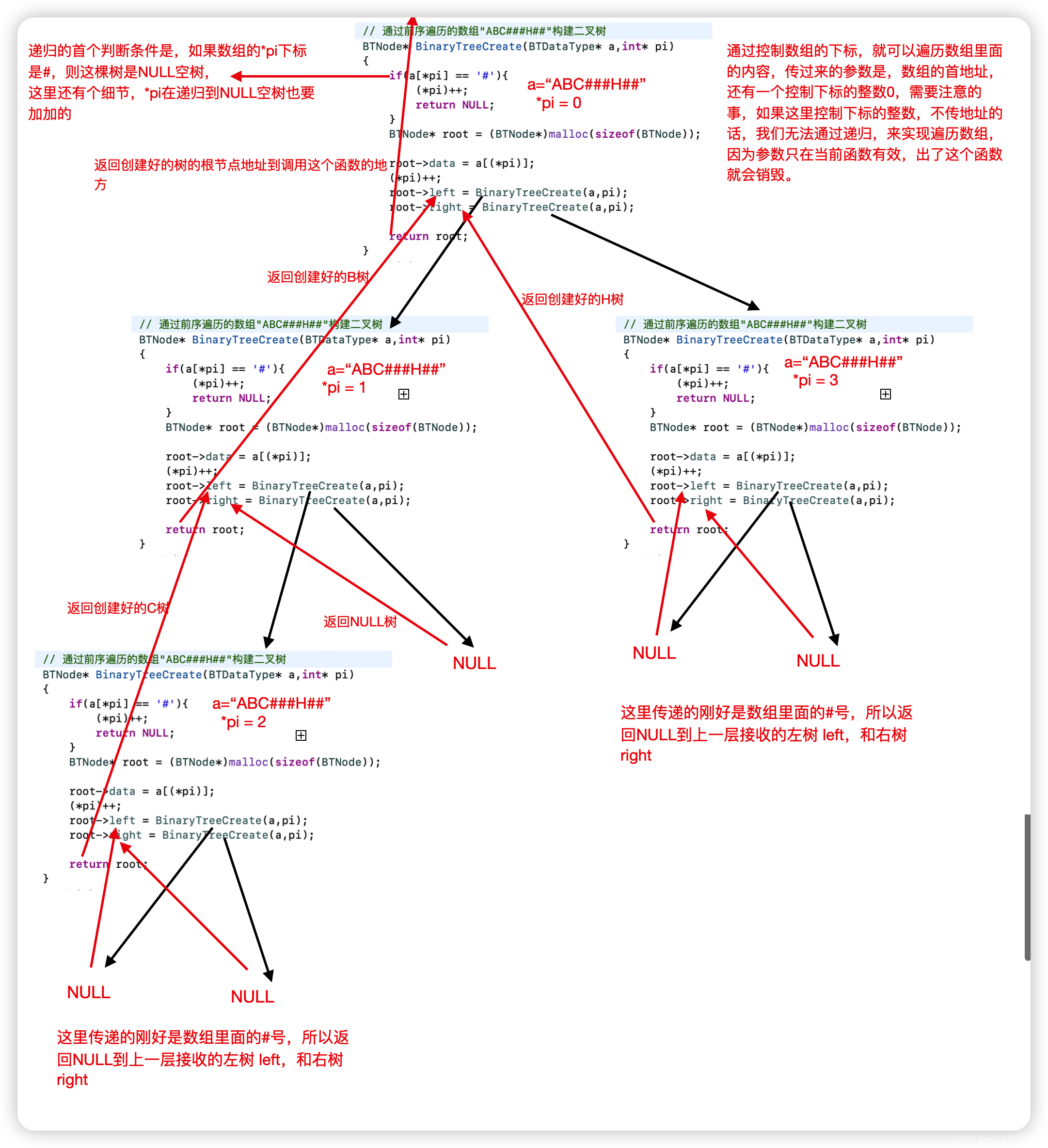
本文含有隐藏内容,请 开通VIP 后查看